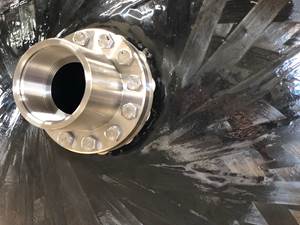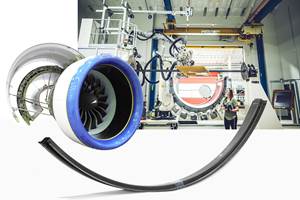Using composites in infrastructure rehab for 30 years
Among many topics, ÂÌñÏ×ÆÞ keeps tabs on composites in infrastructure and construction, a topic being discussed this week as it happens at the American Composites Manufacturers Assn.’s (ACMA) 2017 Infrastructure Day and NIST Workshop in Washington, D.C. Dr. Mo Ehsani is there.

QuakeWrap Inc. uses carbon fiber composites for pipeline and infrastructure repair and improvements.
Among many topics, ÂÌñÏ×ÆÞ keeps tabs on composites in infrastructure and construction, a topic being discussed this week as it happens at the American Composites Manufacturers Assn.’s (ACMA) 2017 Infrastructure Day and NIST Workshop in Washington, D.C. From the very early days of CW magazine’s predecessors High-Performance Composites and Composites Technology magazines, strengthening of concrete columns, beams, walls and pipelines using carbon fiber reinforcements got a lot of ink.
One of the pioneers of this concept of strengthening concrete structure with composites is Dr. Mo Ehsani, professor emeritus of civil engineering at the University of Arizona, a Fellow of the American Society of Civil Engineers and American Concrete Institute, and president of QuakeWrap Inc. (Tucson, AZ, US). He has researched the seismic behavior of structures since 1987, and authored what is reportedly the first technical paper on this methodology in 1990, followed by development of approaches to repair and retrofit civil construction with composites. I hadn’t heard much about Ehsani and QuakeWrap recently until today, when I received an email and a video that caught me up on some of the projects the company has tackled successfully.
We’ve written about the company before. A 2013 story featured a project in which a building in Beirut, Lebanon was reinforced against blast loads using composite fabrics wet out with resins and applied to the walls, both to strengthen the building and to act as a catcher system to prevent debris and wall fragments from entering the building and injuring the occupants. Here’s a link to our 2013 story: http://www.compositesworld.com/news/quakewrap-frp-used-to-reinforce-un-building-in-beirut-lebanon. A YouTube video here shows a demonstration of the effects of blast hardening using a QuakeWrap solution:
Another story describes how QuakeWrap was awarded a Small Business Innovative Research (SBIR) grant from the U.S. National Science Foundation (NSF) to further develop its InfinitPipe concept, also trademarked as StifPipe. Developed by Ehsani, the patent-pending InfinitPipe allows onsite manufacturing of carbon fiber composite pipes that can be miles long without any joints. This is possible because the walls of InfinitPipe are made of a lightweight honeycomb core with carbon fiber as skin reinforcement. This reduces the weight of the pipe to nearly 10 percent of conventional pipes. According to Ehsani, “The mobile manufacturing unit can produce the pipe in a continuous joint-free manner, burying the finished pipe in a pre-cut trench as the equipment travels along the trench.” Just last year, StifPipe received the 2016 American Society of Civil Engineers Innovation Award in the category of “Green Engineering.” Here’s a link to the initial CW story on InfinitPipe: http://www.compositesworld.com/news/quakewrap-wins-sbir-grant-for-pipe-manufacturing-concept. Here’s a link to QuakeWrap’s 2016 press release about receiving the ASCE award: http://pipemedic.com/pdfs/QuakeWrap_2016_ASCE_Innovation_Award_for_StifPipe.pdf. And, here’s a video showing StifPipe in action, in Australia: .
The bottom line is that this company continues to use carbon fiber composites to improve installed infrastructure, around the world, as evident in today’s short video, which you can watch on YouTube: . The company now has a presence on the African continent, and has secured a strategic partner in South America. Recent projects include pipeline repairs in Queensland, Australia, a penstock retrofit in Costa Rica and a large-diameter pipeline repair in Indonesia. The company will have a booth at two upcoming infrastructure events: the Underwater Intervention exhibition in New Orleans, LA, US from February 21-23, and the No-Dig Show focused on trenchless pipe rehabilitation, April 9-13, 2017 in Washington, DC, US. And, Ehsani is in Washington today, invited by ACMA to be part of the discussion on US infrastructure repair strategies for the foreseeable future.
Related Content
Infinite Composites: Type V tanks for space, hydrogen, automotive and more
After a decade of proving its linerless, weight-saving composite tanks with NASA and more than 30 aerospace companies, this CryoSphere pioneer is scaling for growth in commercial space and sustainable transportation on Earth.
Read MorePrepreg compression molding supports higher-rate propeller manufacturing
To meet increasing UAV market demands, Mejzlik Propellers has added a higher-rate compression molding line to its custom CFRP propeller capabilities.
Read MoreThe potential for thermoplastic composite nacelles
Collins Aerospace draws on global team, decades of experience to demonstrate large, curved AFP and welded structures for the next generation of aircraft.
Read MorePlant tour: Airbus, Illescas, Spain
Airbus’ Illescas facility, featuring highly automated composites processes for the A350 lower wing cover and one-piece Section 19 fuselage barrels, works toward production ramp-ups and next-generation aircraft.
Read MoreRead Next
Cutting 100 pounds, certification time for the X-59 nose cone
Swift Engineering used HyperX software to remove 100 pounds from 38-foot graphite/epoxy cored nose cone for X-59 supersonic aircraft.
Read MoreNext-gen fan blades: Hybrid twin RTM, printed sensors, laser shock disassembly
MORPHO project demonstrates blade with 20% faster RTM cure cycle, uses AI-based monitoring for improved maintenance/life cycle management and proves laser shock disassembly for recycling.
Read MoreScaling up, optimizing the flax fiber composite camper
Greenlander’s Sherpa RV cab, which is largely constructed from flax fiber/bio-epoxy sandwich panels, nears commercial production readiness and next-generation scale-up.
Read More












